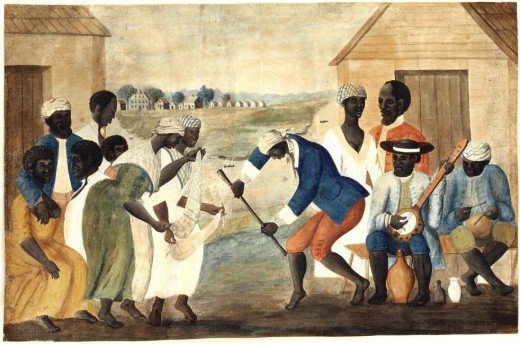Origins of Folk Music
The influence of folk music on contemporary African American music has been immeasurable. There are features that look at African American music as a part of African cultural continuum, and they represent struggles and sorrows, but also empowerment and perseverance. As soon as Africans came to the New World, a gradual transformation of African culture began to what is now called African American. They had to learn how to communicate with each other as they came here speaking many different languages. In order to adjust to the new sounds, surroundings, and customs, they gradually learned to combine the music and the dances they brought from African along with the music and the dances of the Europeans. Music was a group activity that was integrated into daily life among the peoples of Africa. These aspects of African culture were easily adapted into the New World.
Elements of Folk Music
The patting juba was an accompaniment to singing and dancing with rhythmic body percussion. It was an extension of simple hand clapping and was described as “striking the hands on the knees, then striking the hands together, then striking the right shoulder with one hand and the left shoulder with the other- all while keeping timing with the feet and singing.”
The patting juba became an African-American plantation dance as it was originally brought by the Kongo slaves to Charleston, South Carolina. Due to fear of secret codes hidden in drumming, the slaves performed this since there were no rhythmic instruments. Sidney Lanier described patting juba in 1880 as “a quite complex successions of rhythms, not hesitating to syncopate, to change the rhythmic accent for a moment, or to indulge in other highly specialized variation of the current rhythms.”
Work songs were easily integrated to the New World from Africa whenever people worked in groups. Accompanying the movement of the labor, the singing warded off fatigue, lifted their spirits, and enabled slower workers to keep up. This singing could accompany picking cotton, laying railroad tracks, hoeing, and many other slave work. The field holler or field cry was generally described in by the context of the work, such as cotton field hollers, or by the function they served, such as water calls. These songs were sung by an individual working the fields as a short, florid, improvised melody. Field hollers held multiple purposes, like work songs. This included communicating a need or expressing emotion.
Social Implications
African American secular music retained characteristics associated with African music, despite the influence of White European music. The dancing was immediately recognized by outsiders as non-European even if the Africans now knew English or were born in the New World. The notational system designed for European music was the only way to preserve folk music prior to the rise of recordings. The complexity of rhythm was something that the Europeans would try to notate, but would often distort or appropriate the music. Even when African Americans were caricatured in popular minstrel theater, their secular music was brought on to discredit it. However, folk songs still continued to flourish, growing in popularity as the nineteenth century came to a close. Blues and jazz music emerged in the twentieth century and was evident that African American secular music was influential throughout the World.
Primary Performers of Folk Music
Simeon Gilliat was an 18th century slave names Sy who was “unquestionably the most popular society fiddler in Richmond for two generations.” He was the fiddler at the Governor’s Palace in Williamsburg. He was one of the earliest records of the influence that African-American musical style had upon white settlers.
Solomon Northup was an American abolitionist and author of ‘Twelve Years a slave’ which was the first songbook to bring African-American folk music to a wider audience. He was born a free man in 1808, but then was bored from Saratoga, kidnapped, and sold into slavery in 1841. He was rescued an legally obtained his freedom in 1853.
Summary Statement
From hip hop to R&B, African American folk music inspired it all. It is the base of all American music as it ties cultures together. Just like the music of today, folk music expressed the sorrows and pains of everyday life. But it also expressed unity, rejoice, and happiness. Thought the diaspora, we can hear African American sounding different based on its region, but they all bring people together with the natural inclination to dance to the beat. The whites have always tried to treat our music and dancing and modify and commodify it to their comfort without acknowledgment of its origins, but this is something that is unique to our flavor and style.






